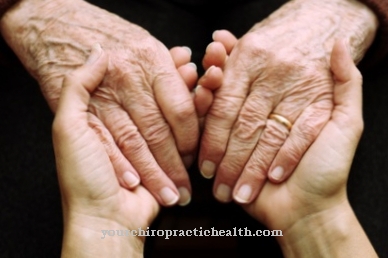At some point they are there: first Gray hair. Many people associate them with a decline in sexual attractiveness and gray hair makes them feel old. The age-related decline in pigmentation cannot really be stopped, but nobody who does not want to have to live with gray hair.
What is gray hair?

Gray hair is the loss of natural hair color. Over time, black, brunette, red or blonde are replaced by a shade of gray that becomes lighter and lighter over time.
This process usually happens very slowly: at first there are only single gray hairs that you see in the mirror, but over time it becomes more and more. Depending on the predisposition, the graying of the hair can be different:
Some people first get visibly gray hair on the sides, while in others it is evenly distributed over the entire head and not particularly noticeable at first. Almost all people get gray hair as they age because it is a natural process.
causes
The cause of the development of gray hair is the age-related decline in melanin production in the body. Melanins are pigment substances which the body forms itself with the help of the protein tyrosine and which are stored in the hair, among other things. If the body's own production of these dyes decreases over time, the hair turns white.
Since not all hair normally turns white at once, the impression of gray hair is created, which is created by mixing white and pigmented hair.
Only at a very old age and not in all people do all hair turn white (snow white). In rare cases, gray hair develops at a very young age, due to stress, mineral deficiency or disease-related pigmentation disorders.
Diseases with this symptom
- Post Traumatic Stress Disorder (PTSD)
- Mineral deficiency
- Malnutrition
Diagnosis & course
If you discover gray hair for the first time at the age of 35, the doctor will explain that this is completely normal.
If gray hair appears earlier, he will ask about family predispositions. It is a diagnosable disorder when the hair suddenly turns gray after a severe shock experience (e.g. post-traumatic stress disorder (PTSD)).
Since hair only has living cells in the root, such a shock-induced graying begins at the hairline and only becomes visible a few weeks later.
Such gray hairs that are not age-appropriate and that are caused by shock or permanent stress and poor nutrition can return to their original color if treated correctly.
However, gray hair that has arisen due to natural aging usually no longer regenerates.
Complications
Gray hair is a normal phenomenon that affects everyone sooner or later. In particular, lighter hair colors turn gray far more intensely, while people with dark hair often retain some color pigments or hardly turn gray. One possible complication is that people get gray hair very early on. The reasons for this are unclear, although they are likely to be found in human genes.
Diseases can also cause hair to turn gray ahead of time. From a medical point of view, there is nothing you can do about it. However, it is possible to dye gray hair and either restore the previous natural hair color or choose a different color. Since the hair now contains no color pigments or only very few, many colors are possible.
However, the user should know that hair colors are highly effective chemical mixtures - and therefore also involve certain risks, which depend on the product and the respective ingredients. Gray hair often becomes brittle and unstable at the same time, which means that it no longer grows as long and is more likely to break off if it is constantly confronted with hair color. For this reason, there are so few old women with long hair - even without chemical influences, it is more likely to break off and not grow back as quickly as it did in younger years.
When should you go to the doctor?
Gray hair is a typical sign of age. There are not a few people who are already beginning to turn gray in their thirties, some even before their 30th birthday. The time of graying is mostly hereditary. Internationally, there are considerable differences in the appearance of the first gray hairs among the individual peoples.
So most of the time, there is nothing to worry about if someone gets gray hair early. Nutrient deficiencies are considered possible causes of premature graying - for example in the case of extreme diets, hormonal diseases and severe stress. Anyone who suspects this can of course consult a doctor. In addition to the family doctor, a dermatologist or endocrinologist is recommended. If gray hair is psychologically stressful, a visit to a psychologist or psychotherapist may also be appropriate.
People who can't put up with their gray hair simply turn to hair dye. The chemicals they contain are often aggressive and can attack the scalp and damage the structure of the hair. Numerous buyers of hair dye products for home use also use the agents improperly. This treatment of gray hair can ultimately make it necessary to see a doctor, preferably a dermatologist.
Doctors & therapists in your area
Treatment & Therapy
Medical treatment of gray hair is only useful in the case of pigment loss that is not age-related. If the gray hair can be traced back to a shock, trauma therapy can help to cope with the experience and to gain new courage to face life. If the person concerned is still young enough, the pigment formation will regenerate again.
If stress, malnutrition and possibly alcohol and nicotine abuse have led to demineralization of the body and thus caused gray hair, stress management training in connection with sport and a diet rich in vital substances helps to regenerate body and soul and to stimulate pigment production again.
Gray hair due to increasing age cannot be treated causally, but it can be covered up cosmetically: Gentle hair dyes are available in almost every imaginable color. If you don't want to use dyes to combat gray hair, you can also try a color care lotion (e.g. Grecian®, Bioloire®). This has to be used regularly and creates a natural dye through a chemical reaction, which is quite similar to natural hair color. The most natural "treatment", however, is to befriend the gray hair as a sign of wisdom and authority.
Outlook & forecast
Gray hair occurs primarily in old age. The hair loses its pigments and grows back more or less dark or light gray. Although it is not a disease, but a normal phenomenon of natural aging - many people still find gray hair uncomfortable and cosmetically annoying.
When they first appear and how long it takes from this point until all hair is gray depends on a person's genetic disposition.Therefore, it is hardly possible to predict when the first gray hairs will appear and when people will become completely gray-haired. Some people's hair never turns gray completely, especially dark hair colors. In others, the hair is completely gray at a young age, but this rarely happens.
Often the hair becomes less full at about the same time as graying, especially in men there is thinning hair growth. Gray hair can be colored if it is cosmetically bothersome. Since it absorbs color differently than hair with its own color pigments, a professional should do the hair coloring.
prevention
Home remedies ↵ for gray hair Who timely against Gray hair would like to prevent, should consistently rely on an ample supply of vitamins and minerals as well as protein. Sufficient sleep and regular stress relief are also helpful in delaying the development of gray hair for as long as possible. Otherwise, there is only the recommendation not to let gray hair grow because of the gray hair.
You can do that yourself
Gray hair is a normal, but often unwelcome, symptom of aging. There is no cure for them, but they can be dyed over with hair color. This makes them visually invisible again and the person concerned initially gets his natural hair color again. However, this also means that it has to be colored regularly.
If, on the other hand, the hair is already completely gray, this can even be an advantage from a cosmetic point of view. You now have few or no color pigments left and are therefore able to take on almost any color you want. A common problem that goes hand in hand with graying hair is thinning and brittle hair that no longer grows really long and is not protected against hair breakage. A regenerative, nourishing hair care, a shampoo that is as gentle as possible for regular cleaning and hair restorers from the pharmacy can help with these side effects.
Especially as they age, many people with graying or gray hair also decide to shorten it. This makes it look healthier again, requires less maintenance and less hair color would be required if it should be colored. Colored tints are an alternative that women especially like to try out. These can also have unnatural colors such as pink, lavender or blue, which, however, only appear very subtle on gray hair like a barely visible shimmer of color.


.jpg)
























